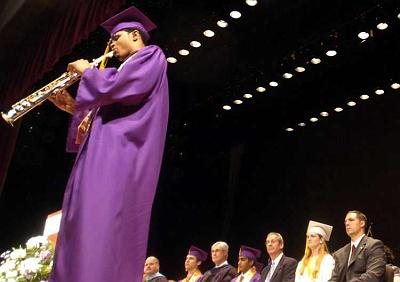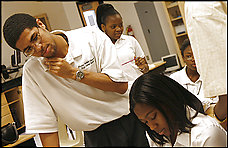Distinguished Black Graduates, 2007 June 9, 2007
Posted by twilightandreason in African American Students, Black Students, Black Youth, Blogroll, Higher Education, Yale.add a comment
Jafar Abdul-Hafiz, Merrillville High School’s first Black male valedictorian, entertains his class with an unconventional commencement address.
Kudos to each of these outstanding Black 2007 Graduates for their exceptional performance as scholars and leaders:
Karen Morris, featured on the Oprah Winfrey Show as the first grandmother ever to graduate from Yale Medical School.
Jonah Brown, president of the University of Kentucky student government for the 2006 – 2007 school year, and chosen as this year’s student commencement speaker. University of Kentucky News describes Brown as “a political science major from Richmond, Ky.,” with an “extensive record of involvement during his four-year career at UK”:
Among several positions of leadership Brown held on campus, he served as a student ambassador for the university as well as the College of Arts and Sciences; he was a residence hall student president and president of the Resident Student Association; he served as vice president of his fraternity and as a delegate to the national Pan-Hellenic Council.
William H. Gray, III, honored at the Princeton Theological Seminary Commencement as this year’s distinguished alumnus (class of 1970). The Princeton Packet describes his achievements:
Mr. Gray is chairman of the Amani Group, a governmental, educational, and business advisory group. He was president and chief executive officer of The College Fund/United Negro College Fund from 1991 to 2004.
Mr. Gray served in the U.S. Congress from 1979 to 1991, was the first African-American to chair the House Budget Committee, and became chairman of the Democratic Caucus. He was also the first African-American in the 20th century to become majority whip of the House of Representatives, a position he held from 1989 to 1991.
He is pastor emeritus of the nearly 7,000-member Bright Hope Baptist Church in Philadelphia, as were his father, William H. Gray Jr., Princeton Seminary Class of 1953, and grandfather before him, and he has been a professor of religion and history at St. Peter’s College, Jersey City State College, Montclair State College, Palmer Theological Seminary, and Temple University.
Mr. Gray earned a bachelor of arts degree in history at Franklin and Marshall College, a master of divinity degree from Drew University Theological School, and a master of theology degree from Princeton Theological Seminary.
Paulette McRae, who became the first African American to earn a Ph.D. in neuroscience from Yale University.
Breanna Fields, who on June 21, 2007 will become Teaneck (New Jersey) High School’s first African American valedictorian. She will graduate at the top of her class of 375 seniors, with a 4.87 G.P.A. In the fall she will begin undergraduate studies at Yale University where she plans to study political science. She offers this advice to incoming Teaneck freshmen:
Set your goals high. Definitely take classes that will challenge you. You can always step down if it’s too hard, but you’ll never have to regret saying, ‘I should have tried that class.’ And be involved, even if it’s one club. You can’t get a full high school experience by just going home after school. You don’t have to do a laundry list of things, but be passionate about what you do.
Martha-Elizabeth Baylor, who upon defending her doctoral thesis in August of this year will become the first African American to earn a Ph.D. in physics from the University of Colorado, Boulder. As an undergraduate at Kenyon College she doubled majored in physics and Chinese. When asked by a local columnist why she chose physics, Baylor responded, “I was never good at English and the humanities. OK, math was a possibility. But, to tell the truth, (physics) was easy for me.”
Jafar Abdul-Hafiz, who recently became Merrillville (Indiana) High School’s first African American male valedictorian. One of six valedictorians (in a graduating class of 505 students), all of whom had 4.0 grade point averages, Abdul-Hafiz was senior class president. He hopes to become a surgeon.
William Chin, Charles H. Flowers High School valedictorian, talks science with fellow classmates.
William Chin, the valedictorian of his graduating class at the largely Black Charles H. Flowers High School in Maryland. Chin, an Eagle scout, scored 2000 on the SAT and was admitted to Duke, the University of Pennsylvania, Carnegie Mellon, Georgia Tech, the University of Virginia, the University of Maryland at College Park, Howard, North Carolina State, North Carolina A&T, and M.I.T., his first choice. He will attend M.I.T. Chin has many fans, including his guidance counselor, Heather Roberts. Says Roberts, “He kind of reminds me of Bill Gates. You know he’s going to do something phenomenal.”
Dorothy Donkor (valedictorian) and Julian Brooks (third in the class), graduating seniors at California’s Rio Linda High School who also happen to be cousins. Both students will attend Stanford University in the fall. Dorothy plans to major in chemistry, while Julian plans to study engineering. Both cousins are part of an exceptional class of African American Rio Linda seniors, four of whom are ranked within the top eight students in the class.
Posted by Ajuan Mance
Different Students, Different Outcomes? June 8, 2007
Posted by twilightandreason in Achivement Gap, African American Students, Black Colleges, Black Students, Blogroll, Current Events, Fryer and Greenstone, HBCUs, Higher Education, income gap, Lezli Baskerville.add a comment
In the 1970s, students attending HBCUs had an 11 percent advantage over their Black counterparts at traditionally White institutions in terms of economic gains. By the 1990s, Blacks at HBCUs were behind 14 percent in terms of salary.– “HBCU Graduates Earn Less Than Black Graduates Of Traditionally White Institutions,” DIHE, 05/17/07
A May 17th article in Diverse Issues in Higher Education reports that a recent study has concluded that African Americans who graduate from majority white colleges and universities earn more money than African Americans who graduate from historically Black colleges and universities (HBCUs). The study, conducted by Roland G. Fryer and Michael Greenstone, hypothesizes that the current discrepancy between the salaries of African American graduates from traditionally white institutions (TWIs) and Black graduates of HBCUs could be due to the improvements made by TWIs in educating Black students.
I looked up the abstract for Fryer and Greenstone’s study, published as M.I.T. Working Paper No. 07-12, to get a better sense of their research on this issue. The following passage from the abstract summarizes their conclusions:
Between the 1970s and 1990s, HBCU students report statistically significant declines in the proportion that would choose the same college again, preparation for getting along with other racial groups, and development of leadership skills, relative to black students in TWIs. On the positive side, HBCU attendees became relatively more likely to be engaged in social, political, and philanthropic activities. The data provide modest support for the possibility that HBCUs’ relative decline in wages is partially due to improvements in TWIs’ effectiveness at educating blacks. The data contradict a number of other intuitive explanations, including relative decline in pre-college credentials (e.g., SAT scores) of students attending HBCUs and expenditures per student at HBCUs.
While Fryer and Greenstone have excluded differences in SAT scores and per-student expenditures as possible explanations for the income gap between Black grads of TWIs and Black grads of HBCUs, I believe that other intuitive explanations remain relevant, like class and acculturation/exposure to the culture and expectations of four-year college education. While the authors of this study go into great detail about the 89 HBCUs that are the focus of their work, they provide considerably less information about the historically white institutions in their research, describing them simply as “comparable.” The question that remains wholly unaddressed, however, is whether or not the students themselves are comparable.
Despite whatever features may link the TWIs and HBCUs examined in this study, the likelihood is that the Black institutions enrolled more GED recipients, more impoverished students, more first generation college students, and more “at-risk” students than the white schools to which they are compared. NAFEO president Lezli Baskerville notes that, “HBCUs educate a significant proportion of low-income, Pell Grant-eligible students,” and asks, “Did the authors control for similar criteria at TWIs? That would make a difference in outcomes.”
Lezli Baskerville and NAFEO have invited Fryer and Greenstone to elaborate on their research at an upcoming conference (July 2007). It is my hope that they will seize this opportunity to address the many questions that have arisen as a result of their challenging and provactive work.
Posted by Ajuan Mance
White at Historically Black Colleges and Universities (HBCUs) June 3, 2007
Posted by twilightandreason in African Americans, Benedict College, Black Colleges, Blogroll, HBCUs, Higher Education, Morehouse College, white students.2 comments
[Morehouse is a] “refuge from the rest of the world where what race you are doesn’t really matter.”
–Steven Schukei, one of a small number of white almuni of this historically Black men’s college
While the media follows the struggles of majority white colleges and university systems to recruit and retain African American students, the success of HBCUs in retaining, welcoming, and supporting the number of white students who attend rarely makes the news.
That is why the May 29th AP article “White Students Being Recruited at Black Colleges” by Katrina Goggins is so refreshing. In it Goggins provides an overview of the current state of white recuritment, admissions, and enrollment at Black colleges. “In the 2005-06 school year, nearly 10 percent of [HBCU] students were white, according to her association’s data,” an impressive figure given the challenge of competing with nearly 30 times the number of majority-white colleges, many of whom have higher budgets and greater name recognition.
Part of Black colleges’ success in drawing more white students can be attributed to significant increases in their efforts to recruit non-Black undergrads, including scholarship and minority affairs offices aimed at addressing the needs of whites and other non-African Americans on campus.
Public HBCUs began actively recruiting white students in the 1980s and 1990s, a period when those public institutions with race- and gender-based missions originally crafted to serve the interests of marginalized groups (people of color and women) were forced to integrate (VMI, the Citadel, Texas Women’s University, and various HBCUs).
According to Goggins, “White students say they’ve taken valuable experiences from their time at black colleges. Skin color, the students say, is much more of a factor away from the campuses than it is on them.” Michael Roberts, an white undergraduate at South Carolina’s Benedict College echoes this sentiment, explaining that “[at Benedict] you should get to know people based on who they are,” Roberts said. “You can’t judge a book by its cover.”
This capacity to see race, but to experience people as more than just their ethnicity is becoming an increasingly necessary skill for white students. Lezli Baskerville, the president and CEO of the National Association for Equal Opportunity in Higher Education believes that white students who choose to attend HBCUs are preparing themselves for
“[an] increasingly Brown and Black world. If you want to know how to live in one, you can’t grow up in an all-white neighborhood, go to a predominantly white school, white cultural and social events, go to a predominantly white university and then thrive in a world that is today more black, more brown than before.”
In the coming years I expect to see more white students attending HBCUs, as popular culture phenomena ranging from the televising of Black college football games to films like Drumline and Stomp the Yard to HBCU-based reality shows combine with increasing reports of the browning of America to make it increasingly clear that white students who have isolated themselves in all white schools located in all white communities are truly being left behind as the nation races ahead into a truly multicultural future.
Read Katrina A. Goggins’s AP report at: http://www.msnbc.msn.com/id/18914514/
Posted by Ajuan Mance


